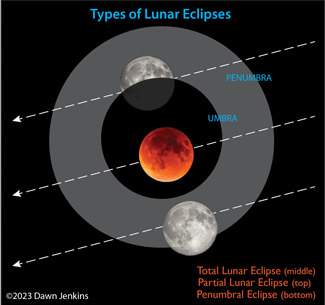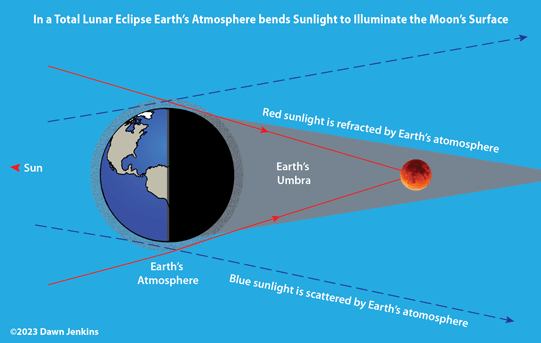
Next Total Lunar Eclipse for North America: March 13-14, 2025
Jump to March 14 Eclipse on this page
Next Total Lunar Eclipse for Asia: September 7, 2025
A lunar eclipse can only occur when the Moon is full, at that time the Sun is on the other side of the Earth. When a lunar eclipse occurs, the Moon moves into the shadow of the Earth, it loses the source of its light and the disk of the Moon darkens.
If the Moon was in a perfect orbit above Earth's equator, every month would bring a total lunar eclipse. Instead, the moon's complex motion is the result of multiple forces that are constantly working on it. The Moon's orbit is inclined about 5 degrees causing it to travel back and forth across the ecliptic. But the ecliptic plane is the plane of the Earth's orbit around the Sun, this means that the Sun and the Earth are both on the plane while the Moon is only on the ecliptic when it cross the nodes. The Solar Eclipse Home page discusses the lunar nodes in detail.
It is only when the Earth and Sun are located near the lunar nodes that an eclipse of the Moon will occur. Each month the Moon crosses the ecliptic twice while orbiting the Earth.

There are three types of lunar eclipse: a total lunar eclipse, a penumbral lunar eclipse and a partial lunar eclipse. The frequency of lunar eclipse is roughly divided between the three types, with partial eclipses occurring a bit less often.
Types of Lunar Eclipses:
A total lunar eclipse can only occur during a full moon when the Moon is behind the Earth and when it is normally fully illuminated by the Sun. Lunar eclipses only occur at night, so observers on the side of the Earth in daylight will not see the eclipse. When the Moon steps into the deep shadow or umbra of the Earth, the surface will be darkened.
A partial lunar eclipse occurs when the Sun, Earth, and Moon are near the nodes but they are not exactly aligned. The Moon moves into the umbra as shown on the top of the lunar eclipse type diagram. Partial eclipses may include any percentage of the Moon's disk less than 100 percent. The umbral phase of the November 18-19, 2021, partial lunar eclipse lasted 3 hours 28 minutes and 24 seconds and was the longest partial lunar eclipse of this century. The Moon's disk was 97.4 percent covered by the umbra. In contrast the partial lunar eclipse of October 28, 2023 will last only 1 hour and 18 minutes. Only about 12.5 percent of the lunar disk will be in the dark shadow.
A penumbral eclipse occurs when the Moon passes through the penumbral area of the Earth's shadow. Penumbral eclipses are not usually dark enough for an observer to detect the shadow on the Moon's disk. The shadow of a penumbral eclipse has no defined edge.
A lunar eclipse is beautiful and for those fortunate enough to be on the side of the Earth that is in darkness will see the coppery disk of the Moon. That is, the Moon usually shows a reddish color that is caused by the Earth's atmosphere scattering the shorter blue light rays from the Sun. This is called Rayleigh scattering and is the reason why the sky is blue. If the atmosphere contains a lot of dust from volcanic eruptions or heavy forest fires, the disk of the Moon may appear darker, grayer, even disappear completely during the total eclipse.


Because the color of the moon is a bit different from total eclipse to total eclipse, astronomers often rate the color. The French astronomer André-Louis Danjon created a useful scale for evaluating the visual appearance and brightness of the Moon during total lunar eclipses. Today this scheme is called, the "Danjon Scale of Lunar Eclipse Brightness" The details below were taken from NASA's Visual Appearance of Lunar Eclipses webpage that can be found by clicking on the highlighted link. The L values describing the luminosities during a total lunar eclipse are defined as follows:
L=0 Very dark eclipse
The Moon is almost invisible, especially at mid-totality
L=1 Dark eclipse, gray or brownish in coloration
Details are distinguishable only with difficulty
L=2 Deep red or rust-colored eclipse
Very dark central shadow, while outer umbra is relatively bright
L=3 Brick-red eclipse
Umbral shadow usually has a bright or yellow rim
L=4 Very bright copper-red or orange eclipse
Umbral shadow has a bluish, very bright rim
The Danjon scale gives the range of colors and brightness the Moon can appear during a total lunar eclipse. It is often used by visual observers to characterize the appearance of a total lunar eclipse. Making an evaluation of an eclipse to assign an "L" value is best done with the naked eye, but binoculars, or a small telescope might help near the time of mid-totality. It is also useful to note the Moon's appearance at various stages throughout the eclipse especially just after the beginning and just before the end of totality. In order to be useful, a notebook to record these impressions is necessary. To make good evaluations, and the date and time must be also recorded as well as the instruments, if any, used during the eclipse.
The Danjon scale does not cover everything pertaining to the color or luminosity during the eclipse. Other scales have seen suggested. The Fischer Lunar Eclipse Scale was developed by Willard J. Fischer. This scale is based on the amount of the Moon's surface details as viewed through various instruments. Other scales look at changes in the Moon's apparent magnitude.
It is interesting to see how the Moon looks during a total eclipse. Some things I find of interest include what part of the Moon looks the brightest, is it the north side or the south? This may change as the Moon moves through the shadow. Early in the eclipse one hemisphere of the Moon can be brighter than the other. If fortunate enough to view the entire eclipse (about 4 hours), it is very interesting to see how the appearance of the Moon changes.
Like solar eclipses, lunar eclipses have magnitudes, that is, the fraction of the Moon's disk that is covered by the Earth's shadow. There are 2 magnitudes for lunar eclipses - – an umbral magnitude and a penumbral magnitude.
Eclipse magnitudes are given as a decimal or as a percentage. The magnitude of a partial eclipse may be denoted as, for example, 0.60 or 60 percent. The umbral magnitude is the fraction of the Moon's diameter that is covered by Earth's umbra at the instance of the greatest eclipse. Greatest eclipse is the moment when the Moon passes closest to the center line of Earth’s shadow cone. For a total lunar eclipse the magnitude can be much larger than 1.00 or 100% because the Earth's shadow is much larger than the Moon's disk.
The penumbral magnitude is the fraction of the Moon’s diameter occulted by Earth’s penumbral shadow. Penumbral eclipses with a value below .5 show no apparent darkening.
Note: These are off-site links that will open in a new window
Mr. Eclipse Lunar Eclipse primer
Upcoming Eclipses of the Sun and Moon
Mr. Eclipse is Fred Espenak, a retired NASA employee who maintained NASA's eclipse pages for many years. The upcoming eclipse pages contain all the eclipses of the Sun and the Moon until October 2024 and links to detail pages of solar eclipses beyond that time frame. Here you will find information on all eclipses of the Sun and the Moon.
Lunar Eclipses - from NASA's Eclipse Page
What is a Total Lunar Eclipses? - from timeanddate.com
Lunar Eclipses - total lunar eclipses only
Xavier M. Jubier is a french eclipse chaser who maintains the interactive Google map eclipse site. He is the inventor of solar/lunar eclipse Google Maps and Google Earth files, author of Solar Eclipse Maestro, Lunar Eclipse Maestro and Mercury Venus Transit Maestro. He has many pages covering the observations he's made and software to download as well.
You may like:
Xavier M. Jubier - Site owner
Software Downloads for Solar Eclipses - includes Lunar Eclipse Maestro




Xavier M. Jubier is a great resource and the March 14 total lunar eclipse page is no exception.
This link goes to an interactive map where users can see exactly how this eclipse will appear from their own location. Use the Zoom function to find a particular location, or better yet, search for the name of your city.
timeanddate.com - March 13–14, 2025 Total Lunar Eclipse (Blood Moon)
If timeanddate.com can access your location, you will be offered a link to a large nearby city. This page will give you the actual local times for each of the eclipse events listed above.
Total Lunar Eclipse Broadcast – March 13, 2025 - from the Griffith Observatory located in Los Angeles, California.
Livestream starts at March 13 from 8:50 p.m. PDT to March 14 at 3:05 a.m. PDT, weather permitting. There is no onsite viewing.
Eclipsewise by Fred Espenak covers all total and partial lunar eclipses. For this eclipse, go to: March 14, 2024 total lunar eclipse

Please feel free to point others to this URL. Images on this page are NOT in the public domain in the U.S.A. The text on this page is copyrighted, ©2023, by the author, Dawn Jenkins, and is NOT released into the public domain. It should not be copied to another site without permission or otherwise published without contacting and crediting the author. Seriously, just ask!
Please read the copyright statement linked below. For more information and other permissions use Astra's Contact Page